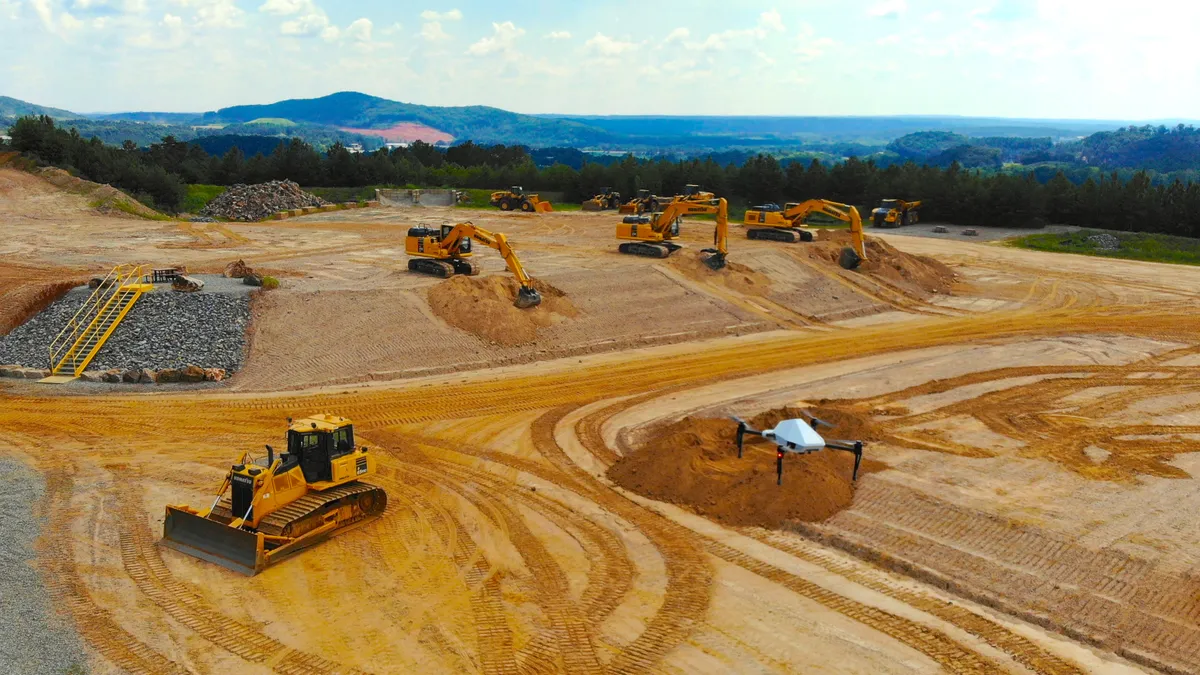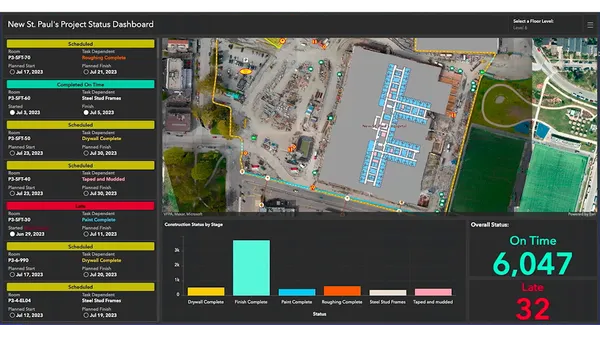Technologies like BIM, drones, virtual reality and real-time workflow software have made an entrance that will forever alter the scope of the construction industry. Every few weeks, Construction Dive provides a roundup of the latest technology product announcements that promise to boost productivity by saving contractors time, money and labor. To view the entire series, click here.
John Deere offers interchangeable controls with new simulator line
Heavyweight construction OEM John Deere has launched a new line of heavy-equipment simulators.
The updates allow for a quick interchange of joystick and foot pedal controls in order to simulate six different machine types: backhoes, crawler dozers, excavators, wheel loaders, joystick-controlled motor graders and fingertip control motor graders.
“The next generation ... teaches machine controls, hand-eye coordination, safe operation, and operator technique,” said Jon Goodney, manager of learning technology for John Deere Construction & Forestry. “Simulators offer cost-effective and efficient operator training in a risk-free environment, while avoiding wear and tear on the equipment. It’s a win-win for organizations looking to get the next generation of operators ready for the jobsite.”
The simulators also pair with free online training through John Deere University.
Autodesk unveils next generation AutoCAD and Revit
Autodesk recently released AutoCAD 2020 and Revit 2020. Long considered industry standards, these iterations fine-tune existing applications — namely, by making them faster, more accessible and more cloud-based. They also throw in a few new offerings.
The AEC software giant incorporated some suggestions from users for Revit tweaks, and introduced new features such as the capacity to capture design intent in detailed documentation and the ability to bring in 2D data via PDF.
Revit now supports SketchUp, so users of that software can import files to Revit workflows.
And, according to Autodesk, “There are substantial improvements to rebar modeling and editing, including new features that will aid designers in concrete stair design,” for instance. “Background processing benefits users in editing complex detailed steel connections,” it continued, noting that users can now “schedule elevations for elements [like ductwork] and use those values in view filters.”
AutoCAD 2020 now has a dark blue interface, offering contrast meant to be easier on the eyes. Processing capacity increases now allow for faster save times, which Autodesk said could add up to save users hours each year.
Users can now just hover the mouse over a 2D drawing to measure distance between objects. Compare features have also been enhanced for viewing two versions of a plan in the same window and incorporating changes from to the other in real time. The software is now also compatible with Microsoft and Box cloud storage systems for collaboration, storage and file-sharing.
DPR to standardize Skycatch drone services across all jobsites
Skycatch’s drone analytics program hit a milestone with an enterprise-wide agreement with DPR Construction, one of its key partners, to standardize and make available Skycatch services and products across all DPR jobsites.
Skycatch has streamlined a formerly fragmented base of one-off solutions to a one-stop commercial-grade kit. DPR saw use in that level of standardization to better implement and manage costs, support and data sharing across its many project sites throughout the country, according to the announcement.
NASA technology can be brought to the jobsite
NASA develops high-tech products and solutions for the most challenging and inhospitable environments imaginable, according to the Association of Equipment Manufacturers, but many in the construction industry aren’t aware that it can bring that cutting-edge technology to the jobsite.
“The technologies that we discover along our path to space have benefits to life back here on Earth,” Steven Gonzalez, NASA technology transfer strategist, told AEM. “Starting from the very beginning, we have been incentivized to use our technology to help improve life, and to create new markets and new industries from our technology,” including construction.
Take Robonaut, for example. Developed to aid astronauts with physical and maintenance tasks in space, the robot utilizes advanced autonomy, sensor networks and robotic controls, the article explains. Those same features go a long way on the ground as well.
“For the manufacturing industry, we created a glove that allows workers in an assembly plant to offload about 10 pounds of pressure from their wrist and their hand so they don't get carpal tunnel from the repetitive motions,” Gonzalez said.
NASA also has years of experience developing and fine-tuning both AI and internet of things (IoT) technology as well, and believes it could be on the forefront of that space, making its offerings ripe for the construction industry to make leaps forward from its traditional stance of lagging in adoption of tech.
More than 1,400 NASA patents and a thousand software applications are available for engineers to peruse and choose to adopt through a partnership with the space agency, the article notes.















